The 2013 MacBook Air Review (13-inch)
by Anand Lal Shimpi on June 24, 2013 12:01 AM ESTThe GPU: Intel HD 5000 (Haswell GT3)
Hire enough ex-ATIers and you’ll end up really caring about GPU performance apparently. It’s good to see that Apple still views increasing GPU performance as non-negotiable, even at the MacBook Air level. Discrete GPUs are out of the question in the MacBook Air, so all models ship with Intel’s on-die processor graphics. More importantly, all CPU choices integrate the largest GPU offering: Intel’s HD 5000 (aka GT3).
Clock speeds alone prevent the 40 EU GPU implementation from being called an Iris 5100. Given the 15W TDP limit, Intel wouldn’t be able to do the Iris name justice even if it tried.
It’s hilarious that Intel refused to give out die photos for anything other than quad-core Haswell GT2, citing competitive concerns, yet at Apple’s WWDC launch of the new MacBook Airs we got to see the first die shot of a dual-core Haswell GT3. Update: I stand corrected. Intel posted its own shot here.
From the die photo it’s very obvious that like the quad-core Haswells with Iris Pro, the dual-core GT3 parts are over half GPU. Here's the only Haswell die shot Intel PR officially released by comparison, a quad-core GT2 part that's mostly made up of CPU cores:
Similar to the CPU discussion, on the GPU front Haswell has to operate under more serious thermal limits than with Ivy Bridge. Previously the GPU could take the lion’s share of a 17W TDP with 16 EUs, now it has 15W to share with the PCH as well as the CPU and 2.5x the number of EUs to boot. As both chips are built on the same 22nm (P1270) process, power either has to go up or clocks have to come down. Intel rationally chose the latter. What you get from all of this is a much larger GPU, that can deliver similar performance at much lower frequencies. Lower frequencies require lower voltage, which in turn has a dramatic impact on power consumption.
Take the power savings you get from all of this machine width, frequency and voltage tuning and you can actually end up with a GPU that uses less power than before, while still delivering incrementally higher performance. It’s a pretty neat idea. Lower cost GPUs tend to be smaller, but here Intel is trading off die area for power - building a larger GPU so it can be lower power, instead of just being higher performance.
| A Historical Look at MacBook Air GPU Performance | |||||||||
| 2011 | 2012 | 2013 | |||||||
| GPU | Intel HD 3000 | Intel HD 4000 | Intel HD 5000 | ||||||
| Manufacturing Process | 32nm | 22nm | 22nm | ||||||
| Frequency | 350/1150MHz | 350/1050MHz | 200/1000MHz | ||||||
| Cores | 12 | 16 | 40 | ||||||
| Peak GFLOPS | 165.6 GFLOPS | 268.8 GFLOPS | 640 GFLOPS | ||||||
| TDP | 17W | 17W | 15W | ||||||
This is an even bigger deal because few of the other OEMs seem interested in paying for the larger die. Acer’s S7 uses Intel’s HD 4400 (Haswell GT2, 20 EUs), as do most of the other Haswell Ultrabooks that have been announced thus far. Armed with a 2011, 2012 and 2013 MacBook Air as well as Acer’s 2nd generation S7, we now have the ability to compare everything from Intel’s HD 3000 (Sandy Bridge) all the way up to HD 5000. It’s important to keep in mind that with the exception of HD 3000, everything here is built on the same 22nm process, and with HD 4400/5000 TDPs actually went down. In other words, post Ivy Bridge, any GPU performance gains were very hard to come by.
I’m splitting up the GPU performance data into three sections. The first is a look at some games/settings that are actually playable on processor graphics. The second is comparison data for laptop Bench. The deltas here are academic at best since nothing slower than Iris Pro can really deliver playable frame rates in our high-end notebook GPU tests. The final section focuses on synthetic performance, which should help characterize the peak theoretical gains you can expect from HD 5000.
All of the gaming tests were run under Boot Camp/Windows 8. I think it’s time to retire the HL2/Portal testing under OS X.
Playable Gaming Performance
There's a surprising number of games that are actually playable on Intel's HD 5000 in the MacBook Air. You have to be ok with the fan spinning quite loudly, but it's possible to get some ultra portable gaming in if you're up for it.
For all of these tests I stuck with 1366 x 768 so I could run comparable data on the only HD 3000 equipped MBA I had, an 11-inch model. I also threw in data from Inte's HD 4400 using the new Haswell equipped Acer S7. I'll start with GRID 2, a brand new racer, running at relatively low quality settings.
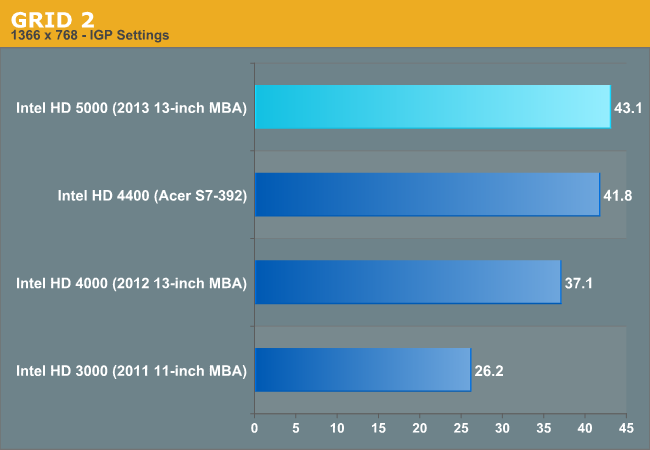
GRID 2 is absolutely playable on the new MacBook Air. At 43.1 fps it's 16% faster than last year's HD 4000 model. A 16% gain without increasing TDP on the same manufacturing process is pretty impressive. The gains over the 2011 MBA are substantial. GRID 2 goes from almost playable to fast enough where you can actually turn up some of the quality settings if you wanted to.
Next up is Borderlands 2. Again, a fairly modern title, but one that's really optimized for current generation consoles - making high-end processor graphics more than up for the task. While a higher TDP implementation of Haswell's integrated graphics wouldn't have an issue here, things are a little more difficult with a 15W TDP.
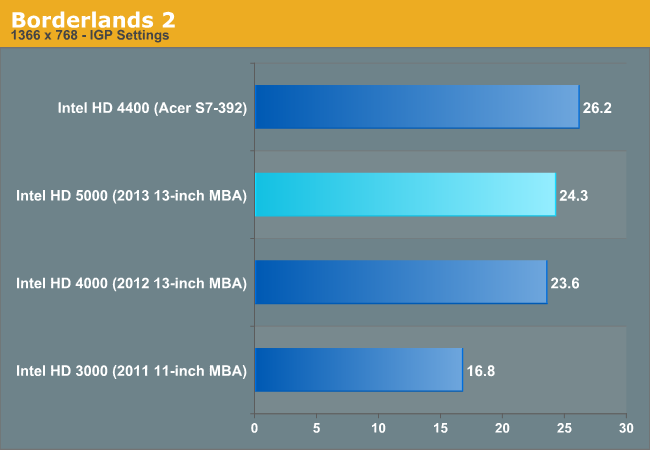
We see a marginal improvement over the HD 4000, we're clearly thermally bound at this point. What's interesting is the HD 4400 on the S7 is actually quicker here. The difference could be cooling or how Apple decides to scale back on GPU frequency when faced with thermal limits. A quick look at Haswell's power reporting confirms that while running my Borderlands 2 test the GPU was already exceeding the PL1 (Power Limit 1) of 15W:

Remember, with Sandy Bridge Intel introduced Turbo Boost 2.0 that effectively allowed for two separate power limits - one equal to the processor's TDP (PL1) and one higher than the processor's TDP (PL2) that could be hit as long as the die temperature doesn't get too high.
Despite the sub 30fps frame rate in this benchmark, Borderlands 2 was definitely playable on the HD 5000. It wasn't always smooth but if you need your single player fix, it'll suffice.
I've had a few requests to bring back our Minecraft benchmark. We ditched it from our higher end GPU reviews since it's no longer stressful enough, but for 15W TDP iGPUs it's perfect.
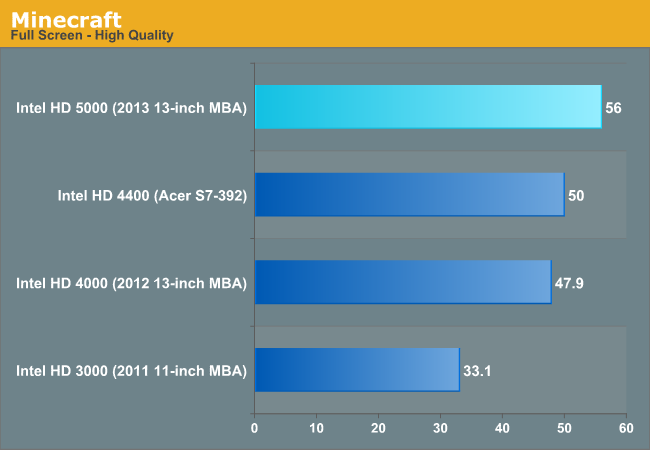
Once again we see almost a 17% increase over Intel's HD 4000. The HD 4400 comparison is also very impressive with a 12% increase in performance vs. what most MBA competitors will be using.
When I was a kid all I wanted was a console that could play arcade quality ports of Street Fighter II and Mortal Kombat II. These days, even the latest Street Fighter title has no issue playing on free graphics:
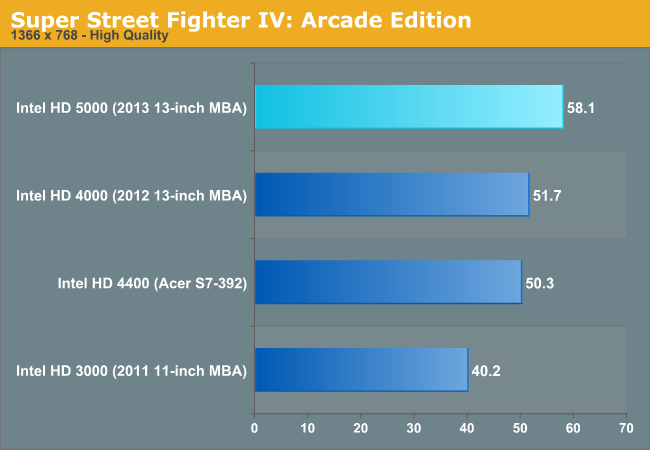
16% seems to be the magic number as that's exactly how much faster HD 5000 is compared to HD 4000. Given the lower TDP this year, that's a pretty reasonable gain. Looking at the sheer number of transistors that had to be used to get there however gives you good insight into just how hard it is to improve performance without a corresponding process node shrink.



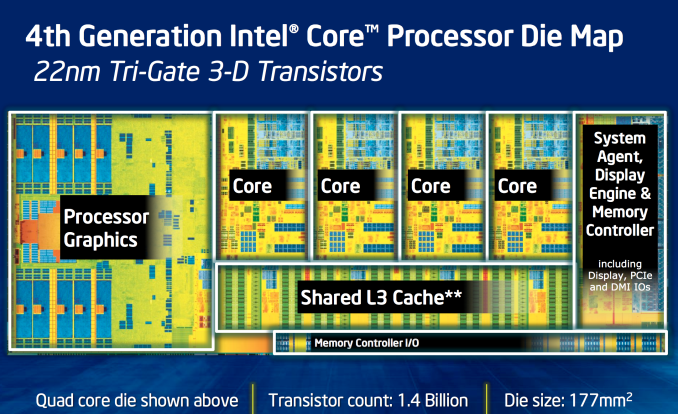
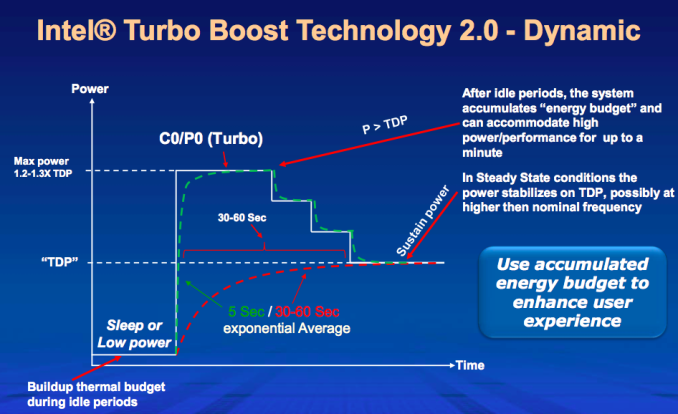








233 Comments
View All Comments
ananduser - Monday, June 24, 2013 - link
I believe this is the first time a company has actually released a slower product than the previous gen. On principle at least Apple should be penalized in the review.Anand may I suggest a battery testing feature ? Count the time it takes to finish one iteration of the looping test. Maybe the battery lasts longer on a certain device but it may also take longer to finish the task. After that "normalize" the results to really measure the improvement.
Paapaa125 - Monday, June 24, 2013 - link
MBA 2013-mid is not really that much slower. It has a lot faster SSD, it has a lot faster WLAN. CPU equal or slower than previous and GPU is faster than previous models. For most usages the net result is a equally fast if not faster computer. Mostly because SSD.captainBOB - Tuesday, June 25, 2013 - link
Instead of going the typical route and using all the extra power savings to increase performance while maintaining the same battery life of last year's model, Apple decided to increase battery life while maintaining performance with last year's model. Its an ultraportable.If you want more juice, get a Macbook Pro, the Macbook Air is all about the ultraportability.
As for the lack of 1080p, on all those other ultrabooks with a 1080p screen, the DPI scaling is upped to 150% by default because people were complaining that text on the screen was too small, Windows still can't handle DPI scaling very well, and I doubt Windows 8.1 will change things because it will most likely be an API and still be up to the developer to update their programs to support higher resolutions. Given the "stellar" track record of the Windows desktop development community and Microsoft itself in actually USING the awesome new APIs that Microsoft creates. The situation isn't going to change the moment 8.1 comes out, it may not change for several years.
Retina may be in the Air's future, but for now the Retina display is what clearly separates the Pro from the Air.
If there is one criticism that is valid, its that the display should've been at least IPS.
ananduser - Tuesday, June 25, 2013 - link
Spare me the marketing talk please...I never mentioned anything about the screen. Why do you feel the need to explain me Apple's motives for that ?They could have very well provided a 9 hour machine with a tangible increase in performance, but hey, Apple fans don't care, everything is perfect in camp Cupertino.
PS: Since you brought it up, the Windows desktop development community is pretty stellar indeed; it's why the best software on the planet, from virtually all categories you wish to name, is made to run on Windows first and foremost. Windows(the software) always handled scaling very well, and having options like 125% or 150% is pretty nifty. Since the display pissing contest just started it will take some time until devs start to obey proper guidelines.
Paapaa125 - Tuesday, June 25, 2013 - link
It's always a tradeoff. Apple went now for maximal battery life with acceptable performance. Most likely they'll focus on performance with rMBP. Sounds logical to me. I think there are many users to whom MBA has enough CPU power and they really need all day battery life. MBA now barely delivers that. Lower battery life would've meant that it will not last all day.ananduser - Wednesday, June 26, 2013 - link
So...we Anandtech readers... we who are the most pretentious of most users... can't we provide criticism ?jmmx - Monday, June 24, 2013 - link
What would like to know is this...I assume that turbo boost speeds will more likely occur when the unit is plugged in - i.e. it will not be draining the battery. Do any of these tests take this into account? (or did I jut not read far enough yet?)
Laststop311 - Monday, June 24, 2013 - link
I totally despise apple and yes it looks like they are making a lot of mistakes with the 2013 refresh. Staying with low res screens and lower clocked processors that are actually a nudge slower than in 2012. But with the the lower clock speeds and massive battery life improvements of the haswells the macbook air is poised to be the longest running ultrabook on battery this year, especially with the larger battery that adds no weight.When you combine the fact that this is haswell, they stayed with low res screens added a larger battery and lowered the cpu frequencies we are in for a real treat with an ultrabook with an insane battery runtime that still has enough power to do everything an ultrabook is used for 99% of the time and do it it with performance in the mid the to midhigh pack with Top battery scores. Not to mention the thermals are probably so much cooler on this air. If Apple left it at 50% would would or probably seen 15 hour idle numbers from apple. And once OSx integrates the power management optimizer feature from haswell those battery life numbers will only go up. Eve more.
I hate apple. But if battery life i you're #1 concern and want to routinely pull 10 hour workdays from your machine without charging the macbook air 13 model 2013 is the ultrabook for you.
KPOM - Thursday, June 27, 2013 - link
All notebooks are about design compromises. Apparently Apple decided to tweak this one for battery life rather than use Haswell as an opportunity to put in a faster processor or better screen. Hopefully they'll find a way to shave a few ounces off the weight of the 13" rMBP. I have one and like it, but miss the portability of the Air.Laststop311 - Monday, June 24, 2013 - link
I wish sata would just completely die off and intel increased in PCI lines by double 80X on enterprise 32x on consumer and have all new HDD and SSD connect via PCI 3.0 1GB/SEC bi directional. Can just use 1x lanes for all the storage devices maybe a few 2x lane connections for super high performance ssd;s. But probably won't see this wish till 2GB/sec bi directional pcie-e 4.0. Where we can easily stack up 8 SSD's on 1s lanes while still providing enough lanes for full GPU use. I hope pci 4.0 brings the full death of sata and its outdated ways. Even if we have to call it sata express. The Use of SATA needs to be fully dead by pci-e 4.0. Yea that includes even having to run a practically obsolete blu ray burners off a 1x line but who knows by then there may be a disc much puerior yo blu ray that can actually use the extra bandwidth. Would simplify computers no longer having to have all that data hardware on there too.